About
Special News
Logan's Page
Jacoby's Page
Our Travel Index
Tracks Ahead Related Trips
Contact
Antarctic Cruise - January 11 - February 1, 2013
Argentina, Brazil, Uruguay, the Falklands and Antarctica
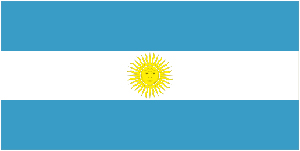 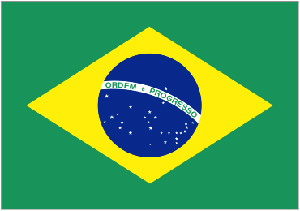 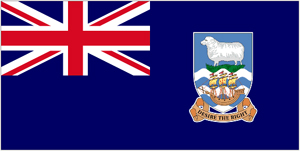 |
We visit Buenos Aires, Iguaçu Falls, Montevideo, the Falkland Islands, and see the last continent on our checklist - Antarctica.
|
Friday/Saturday, January 11/12
The overnight flight from Phoenix to Buenos Aires, by way of Houston, went off without a hitch. We were a little late leaving Houston, but made up for it and arrived around 10:30 AM in Buenos Aires, the capitol of Argentina The flight was the usual cramped, cattle car deal, with uncomfortable seats. We all slept a little, but not enough to really make you feel refreshed. Our travel companions on this trip were friends from Surprise, the Pearsons and the Martins.
Buenos Aires is pretty
much as I remember it; cosmopolitan, bustling, with lots of green space
and statues.
It is large, with a population just under thirteen million.
It was known as the Paris of South
America, and rightfully so, as the man who had a hand in the design of
the French capitol also designed this city in the 1800s.
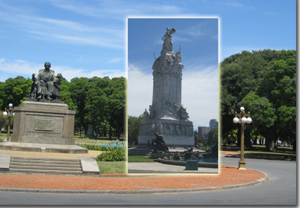 Our guide, Marissa,
picked us up at the airport, and made certain that we were settled in
the hotel.
After a short rest to change clothes,
we headed out for a city tour.
The weather here is quite warm, and on
Christmas day, just a couple of weeks ago, the high was 40+ Celsius.
That’s hot!
Our guide, Marissa,
picked us up at the airport, and made certain that we were settled in
the hotel.
After a short rest to change clothes,
we headed out for a city tour.
The weather here is quite warm, and on
Christmas day, just a couple of weeks ago, the high was 40+ Celsius.
That’s hot!
We hit the usual spots on the bus
tour, such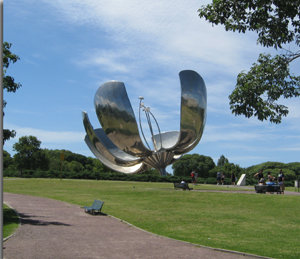 as the older colonial homes (most of which now appear to be
embassies), some of the parks with statues of guys on horses, and some startling
new metal creations.
as the older colonial homes (most of which now appear to be
embassies), some of the parks with statues of guys on horses, and some startling
new metal creations.
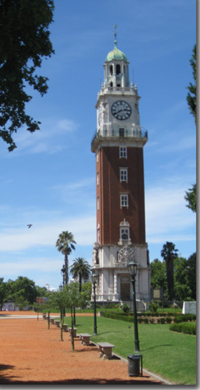 This is the British tower, which is a
monument to – duh – the Brits.
I think that a
later guide told us the tower was now been renamed Freedom Tower,
considering the dustup the Argentines continue to have with the British
over the Falkland Islands.
This is the British tower, which is a
monument to – duh – the Brits.
I think that a
later guide told us the tower was now been renamed Freedom Tower,
considering the dustup the Argentines continue to have with the British
over the Falkland Islands.
Our first stop was the Recoleta
Cemetery, with the obligatory visit to the Duarte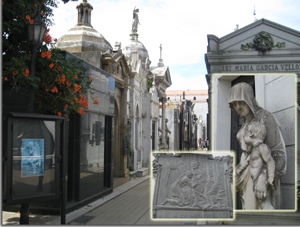 Family crypt, home of
one Eva Peron.
The cemetery was established in 1822,
and the crypts actually descend below street level.
The plot is owned by the family, and
is taxed as property.
If there is no one left in the family
to tend the mausoleum, the site is cleared for someone new.
In fact, some families are selling off
their plots.
Some families are even renting the
site for funerals. After the showy funeral, the deceased is buried in
another cemetery. I was pleased to finally see this, as
I had missed it on my previous visit.
Family crypt, home of
one Eva Peron.
The cemetery was established in 1822,
and the crypts actually descend below street level.
The plot is owned by the family, and
is taxed as property.
If there is no one left in the family
to tend the mausoleum, the site is cleared for someone new.
In fact, some families are selling off
their plots.
Some families are even renting the
site for funerals. After the showy funeral, the deceased is buried in
another cemetery. I was pleased to finally see this, as
I had missed it on my previous visit.
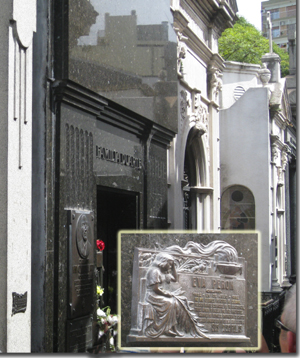
Marissa gave us a brief history lesson, and did not leave much out. Initially I thought that she would gloss over the junta years of the 1980’s, but no, she bravely plowed right into it, and even took us past the spot in town where there is a monument to “The Disappeared.” Argentina today is still under the presidency of Christina Kirchner, and is leaning a bit left with an influence from Venezuela and Cuba. I found that surprising.
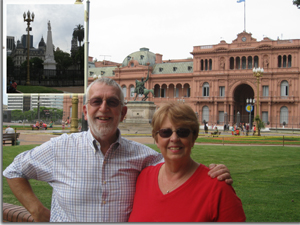
We stopped at the Casa Rosado, the pink palace, which is the government seat, and of course, the balcony made famous by Eva Peron. That balcony is right over Barb's head.
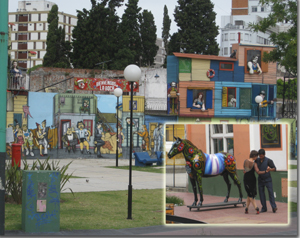 Our last stop was at La Boca, an area
of multicolored dwellings and the usual tourist stops.
This was basically a slum area at one
time, but is known now as the birthplace of the Tango.
As in most South American countries
that I have visited, the power distribution tends to be a little
haphazard.
Truthfully, this was pretty neat,
compared to some I have seen.
And there were a number of people
living on the streets, but there was no mention of them.
I took a brief nap, and now we are off
to dinner (steak of course) and the tango demonstration.
Our last stop was at La Boca, an area
of multicolored dwellings and the usual tourist stops.
This was basically a slum area at one
time, but is known now as the birthplace of the Tango.
As in most South American countries
that I have visited, the power distribution tends to be a little
haphazard.
Truthfully, this was pretty neat,
compared to some I have seen.
And there were a number of people
living on the streets, but there was no mention of them.
I took a brief nap, and now we are off
to dinner (steak of course) and the tango demonstration.
Ah, the Tango
demonstration. We had expected the usual touristy thing, but were
quite surprised. The bus took us to the hip and happenin' Puerto
Madero area,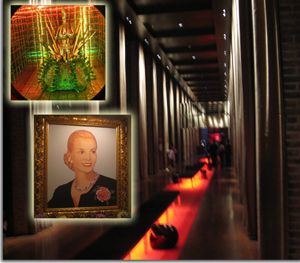 and dropped us at the Faena Hotel, a very upscale (read
that as around US$700/night for a standard room.) While we were here for dinner and the
Roja Tango show, we were initially wowed by the hotel decor and objects'
de art. As stated, the Puerto Madero district is the new hip and
trendy area and consists of converted old warehouses.
There are many clubs, loft apartments,
and upscale dining and shopping.
Dinner was Argentine beef, and the
show was the historical progression of the tango, the Argentinian national dance of
seduction.
It was a very, very good show, with
great music and great dancing.
The presentation featured a live band, 10 great dancers, good vocalists,
and demonstrated the evolution of the dance. You can see a 2:10 clip
here. The
program lasted about two hours, and believe me, by the end we were all ready for
bed.
and dropped us at the Faena Hotel, a very upscale (read
that as around US$700/night for a standard room.) While we were here for dinner and the
Roja Tango show, we were initially wowed by the hotel decor and objects'
de art. As stated, the Puerto Madero district is the new hip and
trendy area and consists of converted old warehouses.
There are many clubs, loft apartments,
and upscale dining and shopping.
Dinner was Argentine beef, and the
show was the historical progression of the tango, the Argentinian national dance of
seduction.
It was a very, very good show, with
great music and great dancing.
The presentation featured a live band, 10 great dancers, good vocalists,
and demonstrated the evolution of the dance. You can see a 2:10 clip
here. The
program lasted about two hours, and believe me, by the end we were all ready for
bed.
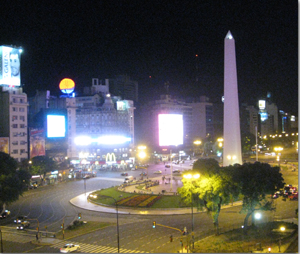
We remember the obelisk on the Avenue Julio 9 as the final view before our eyes slammed shut.
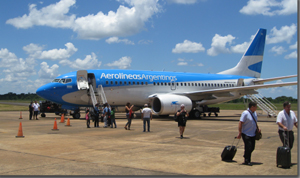 After a too short
evening, five couples (two Arizona, Little Rock, Sacramento and
Scotland) headed out to the municipal airport in Buenos Aires, where we
boarded an Aerolineas Argentina 737 for a just under two hour hop up to
Iguaçu Falls.
After a too short
evening, five couples (two Arizona, Little Rock, Sacramento and
Scotland) headed out to the municipal airport in Buenos Aires, where we
boarded an Aerolineas Argentina 737 for a just under two hour hop up to
Iguaçu Falls.
This cataract, one of the world’s
largest waterfalls, lies on the border of Brazil,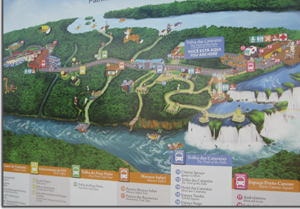 Argentina, and
Paraguay.
They are at the confluence of the
Iguaçu and Paranas Rivers, and consist of multiple cataracts falling
from a height of around 270 feet over a distance of around 2 km.
Today we did the Brazilian
side, which is in a national park and affords a spectacular vistas of
the falls.
Argentina, and
Paraguay.
They are at the confluence of the
Iguaçu and Paranas Rivers, and consist of multiple cataracts falling
from a height of around 270 feet over a distance of around 2 km.
Today we did the Brazilian
side, which is in a national park and affords a spectacular vistas of
the falls.
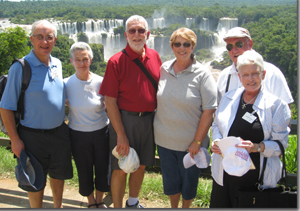
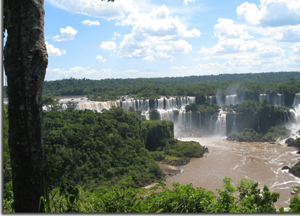 We followed a path along the waterway,
and were able to get great overviews of the falls, which are massive.
Far below us we could see the zodiac watercraft, on which we will get a
good drenching tomorrow. As it was, it was enough to just take in
the massive power and grandeur of this place.
We followed a path along the waterway,
and were able to get great overviews of the falls, which are massive.
Far below us we could see the zodiac watercraft, on which we will get a
good drenching tomorrow. As it was, it was enough to just take in
the massive power and grandeur of this place.
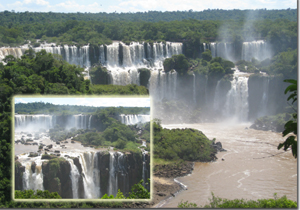
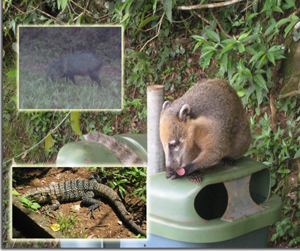 We had no trouble
spotting additional
wildlife. This
raccoon-like creature is called a coati.
These guys were pretty pesky, and
quite bold.
They have teeth and claws, and carry
rabies, so it is best to leave them alone.
This is a request that most of the
locals seem to ignore.
We also saw birds and lizards in
several sizes, as well as a wild pig.
We had no trouble
spotting additional
wildlife. This
raccoon-like creature is called a coati.
These guys were pretty pesky, and
quite bold.
They have teeth and claws, and carry
rabies, so it is best to leave them alone.
This is a request that most of the
locals seem to ignore.
We also saw birds and lizards in
several sizes, as well as a wild pig.
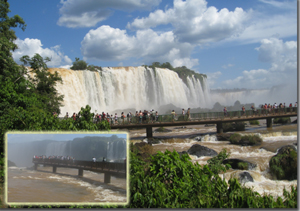 There was a great deal of walking
involved on this trip, and we went out on the catwalks at the base of
one of the falls.
Needless to say, we got wet.
Tomorrow we will be totally drenched,
as we take boats out into the river.
There was a great deal of walking
involved on this trip, and we went out on the catwalks at the base of
one of the falls.
Needless to say, we got wet.
Tomorrow we will be totally drenched,
as we take boats out into the river.
For a :25 clip of the falls, shot with my old digital camera, click here.
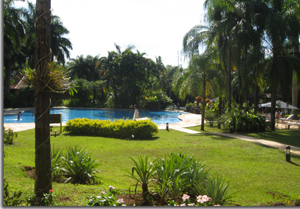
Then it was back to the hotel, which is a lovely establishment, right at the Argentine border. Dinner will be here in the hotel tonight, and an early bedtime. Or that is the plan. Later. The plan held true, and we had a delightful time with Annita and Owen (newly met friends from Glasgow) in the dining room. Note the view of the pool (inside joke).
On the “I learned something new”
gratuities here are supposed to be about 10% and left in cash, as there
is no room for them on the charge slips.
Monday, January 14
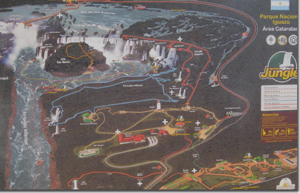 After another much too
short night, as well as an early start, we left the hotel to explore the
Argentinian side of the Falls.
The Argentine side really does offer
quite a different look.
This side gives you spectacular views
of individual groups of falls, while the Brazilian side gives you a vast
panorama of the whole area.
Both are splendid, but in different
manners.
After another much too
short night, as well as an early start, we left the hotel to explore the
Argentinian side of the Falls.
The Argentine side really does offer
quite a different look.
This side gives you spectacular views
of individual groups of falls, while the Brazilian side gives you a vast
panorama of the whole area.
Both are splendid, but in different
manners.
Best of all we were greeted with a
train ride.
A narrow gauge line takes visitors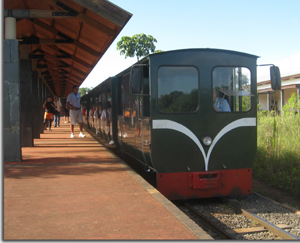 from the central park entrance to two stops along the falls edge.
From
there, you can take several hiking trails.
I’m certain it was put in to cut the
automobile traffic in the park.
And it was a pretty nice little ride.
from the central park entrance to two stops along the falls edge.
From
there, you can take several hiking trails.
I’m certain it was put in to cut the
automobile traffic in the park.
And it was a pretty nice little ride.
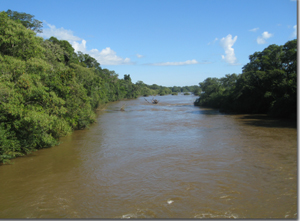 Most of the walk is on
catwalks out over the river. And the river looks deceptively quiet
at this point. There is no hint as to the massive drops that are
just a short distance away.
Most of the walk is on
catwalks out over the river. And the river looks deceptively quiet
at this point. There is no hint as to the massive drops that are
just a short distance away.
We all walked on a catwalk out to
Devil’s Throat, and were amazed at the amount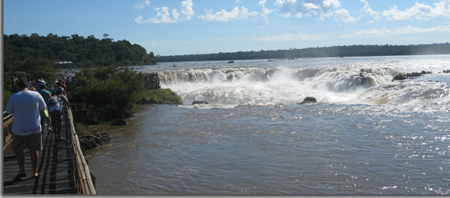 of water just flowing
through this narrow gap.
At 270 feet in height, the roar and
spray of water is more of an experience than a viewing.
of water just flowing
through this narrow gap.
At 270 feet in height, the roar and
spray of water is more of an experience than a viewing.
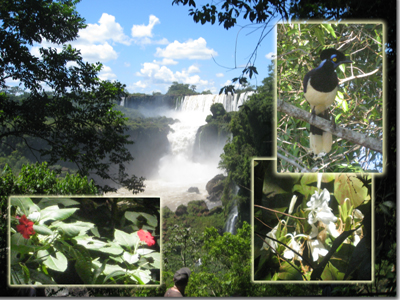 Upon
seeing the Falls, Eleanor Roosevelt was said to have remarked, "Oh poor
Niagara." The whole terrain was caused by an
earthquake around 200,000 years ago which caused the tectonic
displacement.
Lots of water goes through this!
The long walks did give us a chance
for a closer examination of the flora and fauna of the area. There were also a lot of people, and
Barb pointed out that this was summer vacation for the locals.
Well, yes, it is.
See the Falls
here.
Upon
seeing the Falls, Eleanor Roosevelt was said to have remarked, "Oh poor
Niagara." The whole terrain was caused by an
earthquake around 200,000 years ago which caused the tectonic
displacement.
Lots of water goes through this!
The long walks did give us a chance
for a closer examination of the flora and fauna of the area. There were also a lot of people, and
Barb pointed out that this was summer vacation for the locals.
Well, yes, it is.
See the Falls
here.
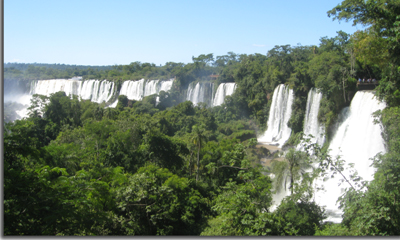 After the Devil’s Throat we did a couple of other trails. So we saw birds, flowers, and more
waterfalls.
In fact, the look at the waterfalls seemed endless.
After the Devil’s Throat we did a couple of other trails. So we saw birds, flowers, and more
waterfalls.
In fact, the look at the waterfalls seemed endless.
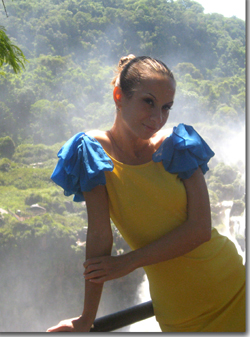 This young lass was apparently trying to make it
into the modeling business with a portfolio shot by her mother.
She is probably also featured in about a bazillion tourist photos!
This young lass was apparently trying to make it
into the modeling business with a portfolio shot by her mother.
She is probably also featured in about a bazillion tourist photos!
And we saw lots of steps, as we
descended to the river level to board the boats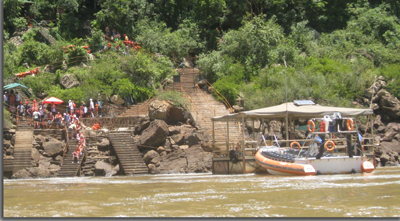 for a soaking ride under
portions of the falls.
While we all had plastic bags to keep
our stuff dry, it was still a delightful drenching!
The boat driver dumped us under the
falls four times. My arm sort of got knocked down by the force of
the falling water, as we got rather close to the last torrent.
for a soaking ride under
portions of the falls.
While we all had plastic bags to keep
our stuff dry, it was still a delightful drenching!
The boat driver dumped us under the
falls four times. My arm sort of got knocked down by the force of
the falling water, as we got rather close to the last torrent.
See a bit of the boat trip here.
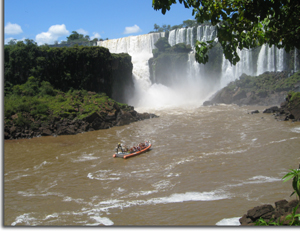 After the passenger screaming died down, we headed downriver to leave
the river a little closer to the park entrance. You remember all those
steps we took to get down to the river? There were an equal number
to get out of the river valley (about 150).
It was quite a hike, and with no handrails for help.
But we made it, and boarded a truck for a
nature drive back through the rain forest to the park entrance.
Of note:
there was no graffiti, no initials
were carved into the paint, and things were pretty well tended and kept.
Americans, take note.
After the passenger screaming died down, we headed downriver to leave
the river a little closer to the park entrance. You remember all those
steps we took to get down to the river? There were an equal number
to get out of the river valley (about 150).
It was quite a hike, and with no handrails for help.
But we made it, and boarded a truck for a
nature drive back through the rain forest to the park entrance.
Of note:
there was no graffiti, no initials
were carved into the paint, and things were pretty well tended and kept.
Americans, take note.
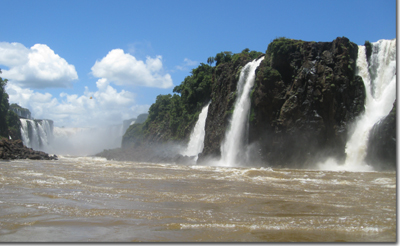 We had a buffet lunch at the park
entrance, and then headed back to the hotel for a nap and a shower.
It was hot today, probably around the
low 30’s, and humid.
While Iguaçu Falls may be on the list
of the top ten natural wonders of the world, I will vote the air
conditioning as one of my top ten.
I’m a wimp!
We had a buffet lunch at the park
entrance, and then headed back to the hotel for a nap and a shower.
It was hot today, probably around the
low 30’s, and humid.
While Iguaçu Falls may be on the list
of the top ten natural wonders of the world, I will vote the air
conditioning as one of my top ten.
I’m a wimp!
Tuesday, January 15
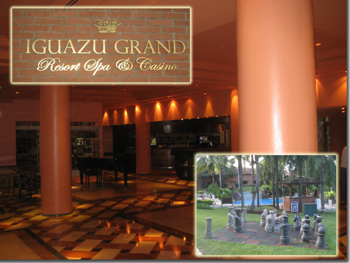 We were up and out of
the hotel by 0745 this morning, and on our way to the airport.
Things are a tad different here than
in the USA, as our guide had our boarding passes ready for us at the
hotel!
So we said goodbye to the Grand Iguaçu
Hotel and Casino. After a short ride and a quick security
pass-through at the Iguaçu Aero Puerto, we said good-bye to a wonderful
couple of days.
The cataracts are an amazing sight,
and we are so pleased that we took the time to do both sides of the
massive cataract. And in addition, we became further acquainted
with new friends.
We were up and out of
the hotel by 0745 this morning, and on our way to the airport.
Things are a tad different here than
in the USA, as our guide had our boarding passes ready for us at the
hotel!
So we said goodbye to the Grand Iguaçu
Hotel and Casino. After a short ride and a quick security
pass-through at the Iguaçu Aero Puerto, we said good-bye to a wonderful
couple of days.
The cataracts are an amazing sight,
and we are so pleased that we took the time to do both sides of the
massive cataract. And in addition, we became further acquainted
with new friends.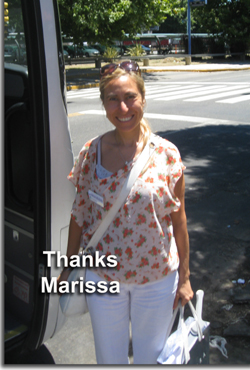
The flight down to Buenos Aires was the usual hop, and we arrived at the downtown airport. Marissa was once again on hand to meet us, and just to kill time prior to ship boarding, heading out to lunch (yet another meal) in the Puerto Madero section. This was a buffet, and as such, was more than ample. We said our goodbyes to Marissa, and headed down to the port for the boarding of the Azamara Quest.
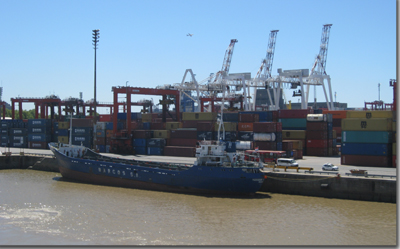
The dock area looks pretty much like any other port area - lots of cranes and containers.
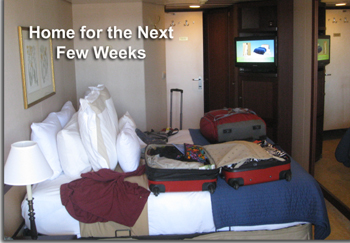
We settled into our new - but temporary - home, and went about the task of unpacking and storing. It was amazing how all our stuff just disappeared into drawers and closets. That is one good thing about cruising - you only have to unpack once.
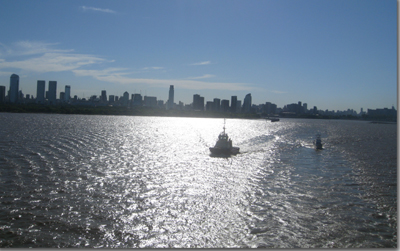
And right on time, in late afternoon, we departed Buenos Aires.
And so our Antarctic adventure begins.
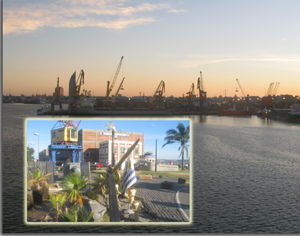 Our
first port of call on the trip was Montevideo, Uruguay.
This small South American country, is
sandwiched between two large neighbors; Argentina and Brazil.
It is still primarily an agricultural
economy, but tourism is coming in second, as apparently the beaches at
Punta del Este are a large draw for German travelers.
Either the Spanish or the Portuguese
were here first, killed off the small indigenous native population, and
then were themselves ousted by the British around 1808.
The French were involved, and so
visitors will see a great deal of differing architecture in the capitol.
Our
first port of call on the trip was Montevideo, Uruguay.
This small South American country, is
sandwiched between two large neighbors; Argentina and Brazil.
It is still primarily an agricultural
economy, but tourism is coming in second, as apparently the beaches at
Punta del Este are a large draw for German travelers.
Either the Spanish or the Portuguese
were here first, killed off the small indigenous native population, and
then were themselves ousted by the British around 1808.
The French were involved, and so
visitors will see a great deal of differing architecture in the capitol.
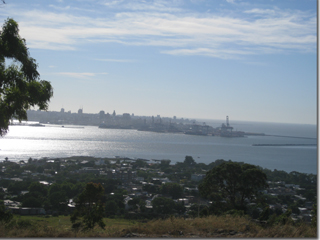 Barb
took a tour of the city, while I did a tour titled “On the Path of a
Legend.”
We basically saw the same things,
although mine had a slightly different slant, which I will explain in a
moment.
Barb
took a tour of the city, while I did a tour titled “On the Path of a
Legend.”
We basically saw the same things,
although mine had a slightly different slant, which I will explain in a
moment.
Truthfully, my initial
reaction to the city was – “What a dump.”
Both of us saw a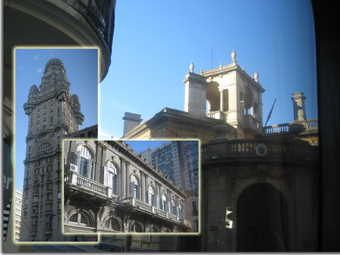 lot of crumbling buildings and sidewalks, broken up bus shelters, and
lots of graffiti.
However, further and closer inspection
revealed some really great old architectural styles, some wonderful
repurposed buildings and some really nice areas of the city.
I guess we just got to see the poor
areas first!
lot of crumbling buildings and sidewalks, broken up bus shelters, and
lots of graffiti.
However, further and closer inspection
revealed some really great old architectural styles, some wonderful
repurposed buildings and some really nice areas of the city.
I guess we just got to see the poor
areas first!
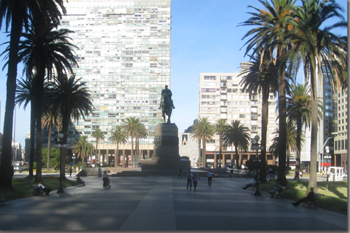 There
were nice green spaces, and I did not see as many homeless as I did in
Buenos Aires, although we might have just been kept away from that part
of town.
Some of the old colonial homes were
quite nice, and even in the middle class areas, many of the homes were
well kept up although small by US standards.
There
were nice green spaces, and I did not see as many homeless as I did in
Buenos Aires, although we might have just been kept away from that part
of town.
Some of the old colonial homes were
quite nice, and even in the middle class areas, many of the homes were
well kept up although small by US standards.
What predominated on all
homes were the bars over the windows and doors.
Plus there was no unprotected parking.
Everything was behind a rather study
fence with gates.
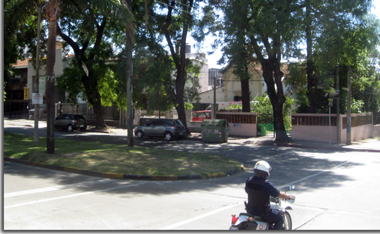 All
of that leads me to believe that property crime is a bit of an issue.
And the graffiti, while some of it
spectacular, also made me think that strict law and order was a bit of
an issue.
We also had a police escort, which
further lead me to believe that all is not quite as orderly as it could
be. The president is a farmer, and still runs his farm in the
evenings, (or so our guide said), which leads me to believe that there
aren’t a lot of presidential duties.
All
of that leads me to believe that property crime is a bit of an issue.
And the graffiti, while some of it
spectacular, also made me think that strict law and order was a bit of
an issue.
We also had a police escort, which
further lead me to believe that all is not quite as orderly as it could
be. The president is a farmer, and still runs his farm in the
evenings, (or so our guide said), which leads me to believe that there
aren’t a lot of presidential duties.
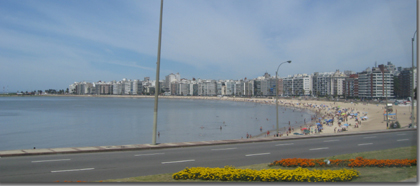 Montevideo
is placed at the mouth of the Rio de la Plata (River of Silver), the
largest fresh water river in the south.
The beaches are pretty nice, and as
the Spaniards used the river to launch cargo ships back to Europe, there
used to be (perhaps still is) lots of lost silver in the river.
In fact, the main beach is named Scuba
Beach, because there used to be so much diving in the area.
Montevideo
is placed at the mouth of the Rio de la Plata (River of Silver), the
largest fresh water river in the south.
The beaches are pretty nice, and as
the Spaniards used the river to launch cargo ships back to Europe, there
used to be (perhaps still is) lots of lost silver in the river.
In fact, the main beach is named Scuba
Beach, because there used to be so much diving in the area.
For me, Montevideo was known for the Battle of the River Plate. A bit of history is necessary. The Treaty of Versailles at the end of WWI said that Germany could have no ocean going warships over 10,000 tons. Hitler skirted that treaty stipulation by turning to his engineers ask asking for technology to make a small battleship (called a pocket battleship or Panzerschiff). The result was the Graf Spee, which launched in 1934. Using electric welding, the lack of necessity for rivets lightened the ship, thus making for a faster vessel, but just over the treaty limit at 12,000 tons. The ship also had ship borne radar, and six 28cm deck cannons. Also on board was a small seaplane used for long range spotting. With a crew of 1,100 men, and a speed of 26.5 knots, this ship was technologically advanced for its time. It was an early German Wunderwaffen (Wonder Weapon).
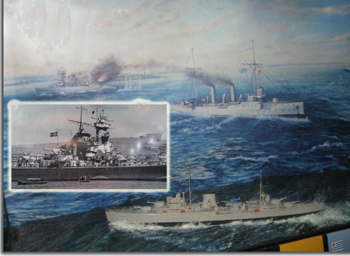 World
War II officially started when Germany invaded Poland on 1 September
1939.
By December of that same year, the
Graf Spee was marauding cargo ships in the north and south Atlantic.
She stopped and sunk ten ships, or
roughly 50,000 tons of material.
In each instance, the crews were
evacuated by the Graf and moved onto tenders, kept on board and
eventually dropped in a neutral nation.
So no lives were lost in any of those
marauding incidents.
Needless to say, this action caught
the attention of the British navy.
World
War II officially started when Germany invaded Poland on 1 September
1939.
By December of that same year, the
Graf Spee was marauding cargo ships in the north and south Atlantic.
She stopped and sunk ten ships, or
roughly 50,000 tons of material.
In each instance, the crews were
evacuated by the Graf and moved onto tenders, kept on board and
eventually dropped in a neutral nation.
So no lives were lost in any of those
marauding incidents.
Needless to say, this action caught
the attention of the British navy.
On 13 December, the Graf was spotted by the British cruiser Exeter, which opened fire. Two additional British cruisers raced in to help, the Ajax and the Achilles. In the battle, the Exeter was heavily damaged and retired to the Falklands. But the Graf was damaged as well, primarily in the engine cooling systems. The Graf’s captain, Captain Landsdorf, limped up the Plate to Montevideo, claiming sanctuary in neutral Uruguay. He initially received 24 hours, later extended to 72 hours to fix his ship and get out of Montevideo harbor.
The British instituted an intelligence scam that led Landsdorf to believe that the British had blockaded the mouth of the Plate River. In actuality, the Graf could easily have sailed past the damaged Achilles and Ajax, and perhaps made its way back to Germany. But the ship had technological value, and Landsdorf was ordered not to let the ship fall into enemy hands. On the evening of 17 December, just as the Graf Spee was supposed to be sailing out of the harbor, onlookers were startled to see the ship scuttled.
Landsdorf committed suicide in Argentina several days later, wrapped in a German Nazi flag. Landsdorf had three children, two boys and a girl. The daughter is still alive. And the Graf Spee still rests on the bottom of the Rio de la Plata.
In one of histories little twists, the ship was named for a German Admiral who commanded a ship in the Battle of the Falklands in 1914. Admiral Maximillian Spee was the next door neighbor to Lansdorf, and encouraged the lad to go into naval service.
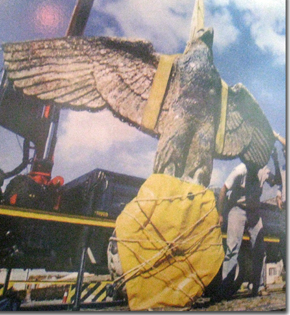
The Graf Spee’s Kriegsmarine Eagle symbol was found and brought to the surface some years ago, but is now in storage (no one knows exactly where) as it is apparently worth millions of dollars.
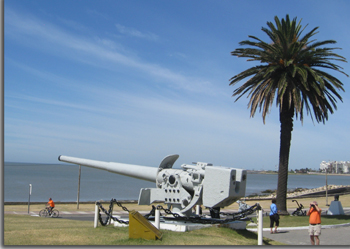
So that was my tour. One of the guns of the ship is on display at the naval museum.
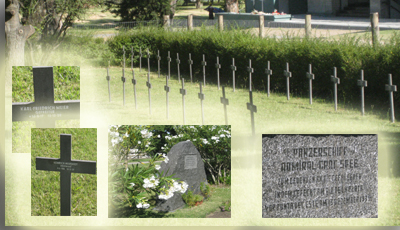 We
visited cemeteries of the German sailors who died here, as well as the
British sailors who lost their lives.
We
visited cemeteries of the German sailors who died here, as well as the
British sailors who lost their lives.
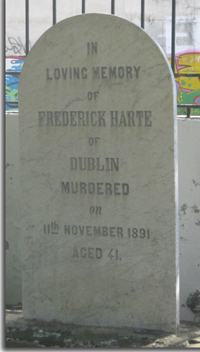
The cemeteries were somewhat interesting, including a tombstone that gave a rather vivid description of the person’s demise.
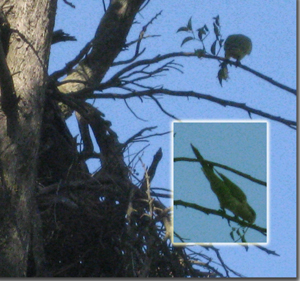 And
for the birder in our lot, we saw a parrot’s nest, which is quite large.
I was told later that this is a mock
parakeet.
And
for the birder in our lot, we saw a parrot’s nest, which is quite large.
I was told later that this is a mock
parakeet.
After the return to the ship, we were treated to the fuel tender topping us off for our voyage over to the Falkland Islands, and a view of warships as we sailed out of the Rio de la Plata and off into the South Atlantic Ocean.
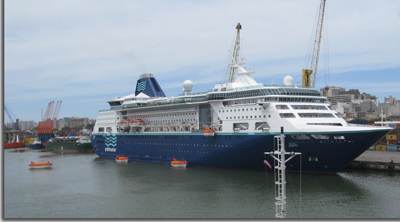 By
the way, the German tour boats apparently have more fun than we do, as
the crew was out testing the lifeboats.
I doubt however, that any passengers
were on board.
By
the way, the German tour boats apparently have more fun than we do, as
the crew was out testing the lifeboats.
I doubt however, that any passengers
were on board.
Two days of sailing await us before our next landfall. It looks like rain. We have had great weather so far, but it is supposed to get colder – much colder.
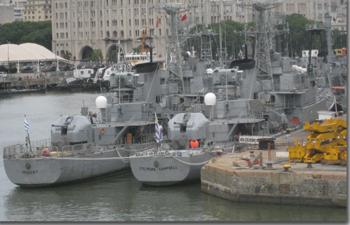 The
evening entertainment was a guitar player.
I would guess that about 30% of the
audience did not like him, as the music was harder rock, but I thought
he was great.
The
evening entertainment was a guitar player.
I would guess that about 30% of the
audience did not like him, as the music was harder rock, but I thought
he was great.
Thursday, January 17
There is not a whole
heck of a lot to say about today.
We all awakened late, at a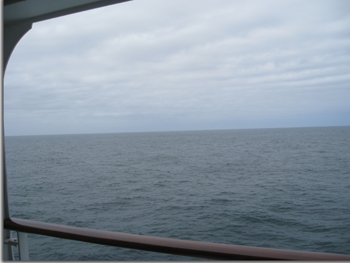 position which put Montevideo about 275 miles to the northwest on our
way to the Falklands (The Isle Malvinas).
It was rather foggy most of the day.
position which put Montevideo about 275 miles to the northwest on our
way to the Falklands (The Isle Malvinas).
It was rather foggy most of the day.
We attended several on board lectures, the first of which dealt with the animals of Antarctica. The only indigenous continental animal is an insect, a type of midge. We learned a bit about the penguins, and the seals. Seals can stay underwater for over an hour, and dive to depths of 450 meters. They are able to do so by physiologically having more red blood cells, and having the ability to divert oxygenated cells away from non-essential organs, such as the stomach (could I do that?).
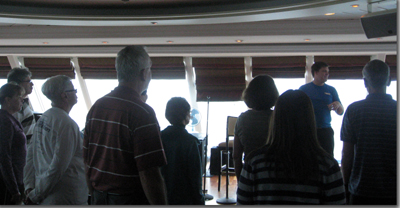 I
hung around and took a flyer by joining the on board choir with Anne
Martin, Paul Pearson and about 40 of our fellow travelers.
I guess we will see how that works
out.
We played a game this afternoon to
kill some time, and the rest of our group went to Trivial Pursuit where
they were introduced to Robyn, the blond from last night's floor show.
I
hung around and took a flyer by joining the on board choir with Anne
Martin, Paul Pearson and about 40 of our fellow travelers.
I guess we will see how that works
out.
We played a game this afternoon to
kill some time, and the rest of our group went to Trivial Pursuit where
they were introduced to Robyn, the blond from last night's floor show.
Our home from the reverse angle.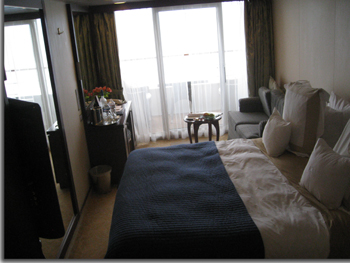
We were to attend a lecture on Schackleton, but instead got a show and tell with Nigel Marven, some British TV dude cast in the shoes of Steven Irwin, the deceased crocodile hunter. He showed some clips of things like leeches (yum) and snakes (ick), and was sort of good but not to my liking.
All in all, this was a slow day.
We had dinner in the
Prime C, one of the upscale restaurants, which was quite good.
But prior to that, I was able to cross
off one of my life list items.
It was a small thing, but one I had
never experienced – the green flash of sunset.
As the sun sinks over the horizon on a
perfectly clear day, you get a momentary flash of emerald light as the
light waves are bent around the earth’s curvature.
I’ve attempted to see it for years, to
no avail.
But this time the conditions were
perfect.
Yippee skippee!
Friday, January 18
I got up early and went to morning stretching, which was quite crowded. Barb stayed behind and saw a whale spout - as it turns out it was the first of many. I think she got the better deal.
The morning lecture, by Chuck Richardson, our Destination Speaker, was about the history of the Falkland Islands. Initially mentioned by the Dutch in the late 1600s, the prime players here were Spain, Britain and the French. The USA actually had a hand in things, but only briefly. The British claimed the islands in 1776, and things have been slightly unsettled ever since. The importance of the islands was much greater as a refueling, provisioning and repair stop prior to the completion of the Panama Canal. After that, the islands sort of fell into the category of “everyone knows they’re down there, but nobody cares.”
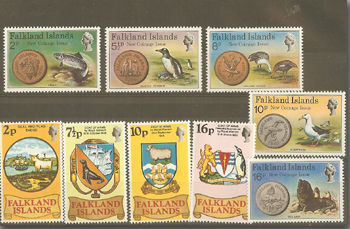 But
then evidence of oil deposits appeared.
So all of a sudden, Argentina started
relaying a claim to the place.
One of the first governors was an
Argentinian, thus enhancing the Argentine claim to the islands.
Geographically the islands are a part
of the South American plate, and far removed from the British Isles.
The islands are self-sufficient, and
actually consist of over 700 islands, two of which are the inhabited
areas, east and west island.
There are lots of penguins, and seals,
as well as sheep.
And a whole bunch of left over
minefields from the 1982 conflict with Argentina.
But
then evidence of oil deposits appeared.
So all of a sudden, Argentina started
relaying a claim to the place.
One of the first governors was an
Argentinian, thus enhancing the Argentine claim to the islands.
Geographically the islands are a part
of the South American plate, and far removed from the British Isles.
The islands are self-sufficient, and
actually consist of over 700 islands, two of which are the inhabited
areas, east and west island.
There are lots of penguins, and seals,
as well as sheep.
And a whole bunch of left over
minefields from the 1982 conflict with Argentina.
Stamps are a source of
revenue, and some of the early stamps can be quite valuable.
Saturday, January 19
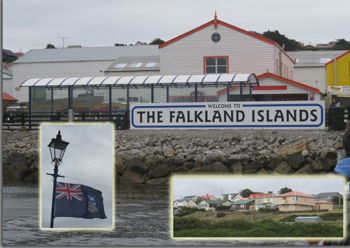 We
anchored off Port Stanley, capital of the Falkland Islands right on
schedule.
After a short ride on the tender we enjoyed a walk around the city.
While the weather was somewhat grey,
around Noon things cleared up.
This was a good thing, as I will
relate.
We
anchored off Port Stanley, capital of the Falkland Islands right on
schedule.
After a short ride on the tender we enjoyed a walk around the city.
While the weather was somewhat grey,
around Noon things cleared up.
This was a good thing, as I will
relate.
We met our guide, Ruth, for a walking tour of Port Stanley. The whole population of the Falklands is around 3,000 people, with about 2,100 living in the capitol. In fact, the West Island has less than 500 people on the whole thing. The mainstay here is agriculture in the form of sheep and cattle, but they think that the people are sitting on oil deposits, and everyone is quite excited about it. Of course, that also explains the Argentine desire to assimilate the place. While there isn’t much here, we did get a flavor of life on the island. In a word – quiet. There seem to be few people who leave, and many who come here wind up staying. It really is a quiet little corner, away from the commotion and hectic pace of the rest of the world. Children complete their schooling in Britain, and while you would expect them to stay there, most return to the island. The residents have medical facilities, but specialty doctors rotate through and if you need to have a joint replacement evaluation (for example) you have to wait for the ortho doc to show up. Generally you then have to go to Britain for specialty work. Our guide had to run up to Santiago for some regular treatments. She also said that due to the quiet life, there is a bit of a drinking culture. Having had the lake cabin, I can identify with that! The climate is much like southern England, although with more days of sun but without the moderating effects of the Gulf Stream.
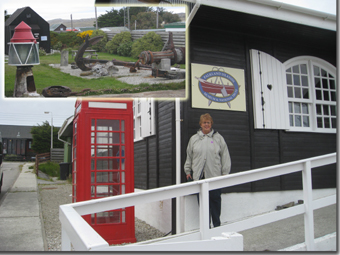 First
stop was a small museum, complete with English style telephone booth.
First
stop was a small museum, complete with English style telephone booth.

As this was summer, flowers were blooming in abundance.
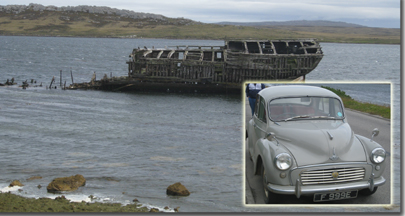
We passed an old wreck of a wooden sailing ship, and even discovered a more modern relic - a Morris Minor.
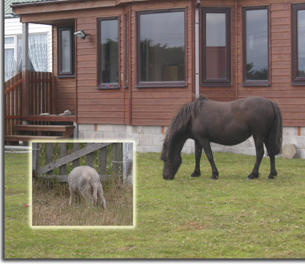
While most people keep dogs and cats, apparently city ordinances allow for other animals as well.
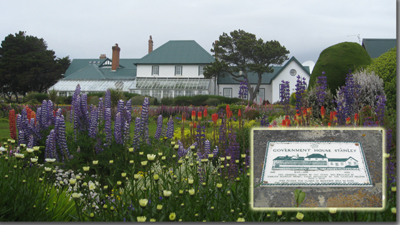
We passed Government house (a Queen appointed governor and elected legislative advisors), and then several war memorials.
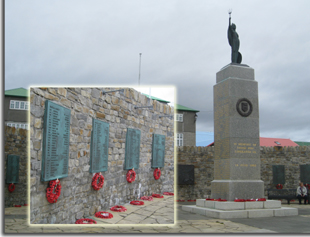 These
are specific to the Falklands wars of 1914, and the latter one in 1982.
These
are specific to the Falklands wars of 1914, and the latter one in 1982.
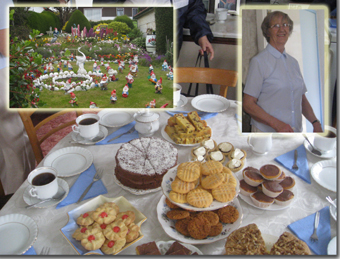
We stopped at a charming private home for tea and cakes, and admired the woman’s gnome collection, which has been acquired over a 36 year period.. The flowers were out in bloom, and the houses, while small, were well tended. Everyone seems to drive a 4x4, as there is so much unpaved road, or in some cases, no road.
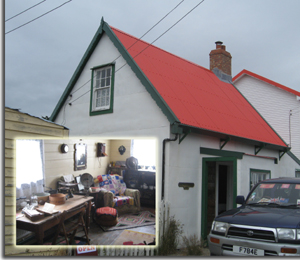
I ducked into Cartmell Cottage, for a look at how life was in 1890, the 1940’s and the 1950’s. Everyone was friendly, wanted to chat and show the place off.
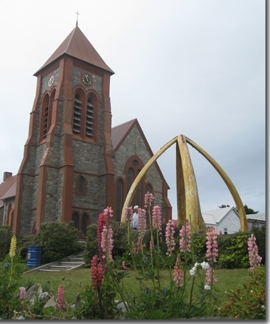
We stopped by the Anglican Church, with its whale carcass arches. This is probably the most photographed spot in town.
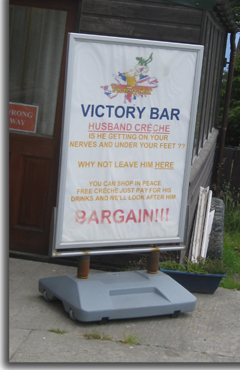
We stopped for a beer in a local pub. The beer was not particularly good, and the clue should have been that the locals ordered Heineken. But still, when in Rome…..
That took us to Noon, and the sun came out, and off came the coats.
And off we went to Bluff Cove to see the penguins. I must say, this was pretty amazing. After a very rough (did I mention very rough) cross country drive, we arrived at the penguin breeding grounds at Bluff Cove.
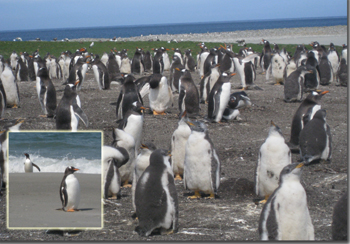 And
there they were, mostly chicks, just losing their down, having been
hatched in November.
The parents were still gathering
groceries from the sea some distance away.
We enjoyed watching the adult penguins "march" back and forth to the
sea.
These are mostly Gentoo penguins, But
we there were a few King penguins in the middle of the group.
Penguins are of different species, and thus can't interbreed.
While they live together, they can't interbreed.
And
there they were, mostly chicks, just losing their down, having been
hatched in November.
The parents were still gathering
groceries from the sea some distance away.
We enjoyed watching the adult penguins "march" back and forth to the
sea.
These are mostly Gentoo penguins, But
we there were a few King penguins in the middle of the group.
Penguins are of different species, and thus can't interbreed.
While they live together, they can't interbreed.
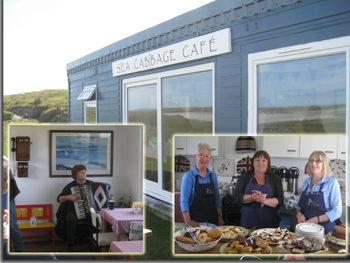 Out
at the Cove, there was a little refreshment stand, the Sea Cabbage Café,
with tea and cakes, and three lovely ladies to make certain we all
abandoned whatever dietary pretensions we might have had. They
bake each day and we were treated to delicious cookies.
And of course, we had local music, of
the accordion variety.
Out
at the Cove, there was a little refreshment stand, the Sea Cabbage Café,
with tea and cakes, and three lovely ladies to make certain we all
abandoned whatever dietary pretensions we might have had. They
bake each day and we were treated to delicious cookies.
And of course, we had local music, of
the accordion variety.
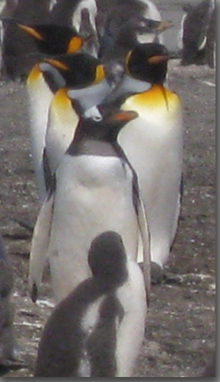
There were a couple of King Penguins, distinguished by their golden throat feathers.
The landscape was remote, sparse, and forbidding. It was pretty desolate, and the rock rivers and formations were sharp.
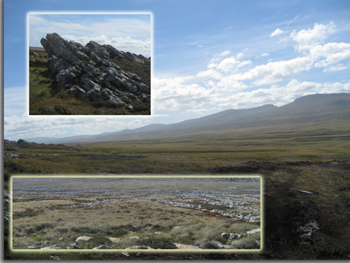
Then it was back into our 4x4 and a return off road trip (did I mention a rough ride?) through the peaty soil, with Guernsey Banded cows, and to the ship.
We will leave about 7 PM
this evening for another day at sea on our way to Elephant Island, our
link to the Antarctic continent.
Sunday, January 20
Today saw us leaving Port Stanley and the Falkland Islands. As we headed south, we passed over the Scotia Ridge into the Scotia Sea, on our way to Elephant Island. We will not make port there, as there is virtually nothing to see other than a Chilean weather station, but at least we’ll get a look at the Antarctic Peninsula. The captain said that we may not ever get too close, as there are many icebergs (henceforth referred to as simply “ice”.)
The day was spent relaxing, watching the deep blue ocean roll past the windows, and waiting for the fog and sea haze to abate. We attended an interesting lecture on the captain and his bio, and then a lecture on the ice sheets on the Antarctic continent. There is a great deal of concern, as these sheets are melting faster than any time in history. At the center of the continent, the ice can be up to two miles thick. The pressure causes the ice to spread out down the valleys out to the seas, and eventually calve or break off to make the giant floes. We will see more in the next several days.
At the moment, though, the eating contest continues and we are playing nonsensical games such as trivia with individual teams and the men vs. women. It is actually a bit of fun, and generally hilarity ensues. The football semifinals are on tonight, and tailgating food (!) is promised. I wonder if the Packers had been in, would there be fried cheese curds? More food. Yikes.
I spent the afternoon relaxing, and ended up doing laundry. In my gregarious mode I had a lovely conversation with two women from Canada. Sometimes I just want to be by myself, but other times a have found that I really enjoy meeting new people and finding out their stories. It must be something I picked up from my TV work.
The entertainment
program tonight was an acappella presentation by the singers and
dancers.
It was fun, and quite entertaining.
Monday, January 21
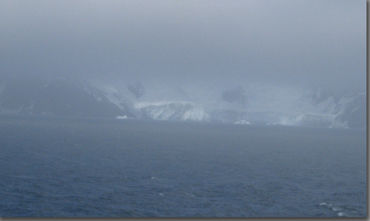 This
morning found us around latitude 60 degrees, and off a fog enshrouded
Elephant Island.
The temperatures will be in the 40's,
and that will hold for most of our time here. That isn't too
awfully cold for us Mid-Westerners, but the wind does add a little bite
to the air. This was the island on which the
Shackleton Expedition landed in 1914.
The place is remote and forbidding.
As you know, his ship got trapped in
the ice, and most of his crew stayed here on the island while Shackleton
sailed to get help.
The stranded crew existed on penguins,
seals, and blubber before Shackleton returned with a Chilean fishing
trawler and rescued them.
Not a single life was lost.
This was pretty amazing when you
consider that these guys had 22 foot longboats and rowed their way into
the island. The
crew landed initially at Valentine Point, but them moved down the island
shore for more favorable landing conditions.
This
morning found us around latitude 60 degrees, and off a fog enshrouded
Elephant Island.
The temperatures will be in the 40's,
and that will hold for most of our time here. That isn't too
awfully cold for us Mid-Westerners, but the wind does add a little bite
to the air. This was the island on which the
Shackleton Expedition landed in 1914.
The place is remote and forbidding.
As you know, his ship got trapped in
the ice, and most of his crew stayed here on the island while Shackleton
sailed to get help.
The stranded crew existed on penguins,
seals, and blubber before Shackleton returned with a Chilean fishing
trawler and rescued them.
Not a single life was lost.
This was pretty amazing when you
consider that these guys had 22 foot longboats and rowed their way into
the island. The
crew landed initially at Valentine Point, but them moved down the island
shore for more favorable landing conditions.
The fog did lift, and we
saw our first iceberg, complete with penguins.
The size is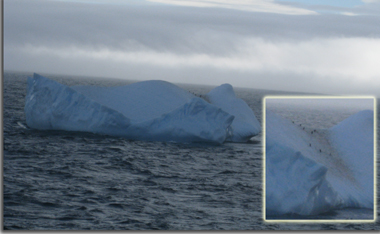 deceiving and perhaps the tiny dots, which are the penguins, will offer
some perspective.
deceiving and perhaps the tiny dots, which are the penguins, will offer
some perspective.
Finally the sun lighted up the island, and lots of photos were taken. Note how the glacial ice runs in sheets down to the water, where it breaks off (calves) and floats way. As this was our first look, we were all very impressed.
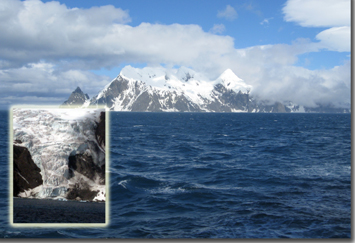
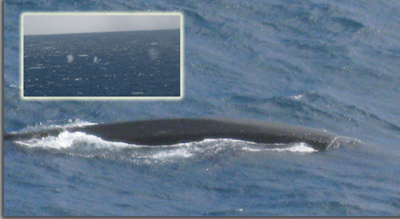 Of
great interest was a large pod of blue whales that were in the area and
quite close to the ship.
The captain said that he had never
seen so many in one place.
There were blows in every direction,
and even I, who is slow to spot this kind of thing, saw plenty of
examples.
In fact, I even got a couple of photos
of the whale backs on the surface.
And you could see the shape just under
the water.
It was pretty neat.
Of
great interest was a large pod of blue whales that were in the area and
quite close to the ship.
The captain said that he had never
seen so many in one place.
There were blows in every direction,
and even I, who is slow to spot this kind of thing, saw plenty of
examples.
In fact, I even got a couple of photos
of the whale backs on the surface.
And you could see the shape just under
the water.
It was pretty neat.
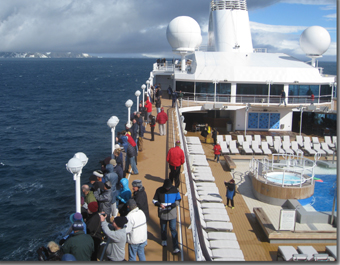 It
is cold, and people are well bundled up, as with the wind, the wind
chill factor was probably pretty low.
You would not last long in these
conditions, especially if you went in the water.
The crew helped to keep the chill off by serving us hot chocolate with a
shot of rum and mulled hot wine. Yummy!
It
is cold, and people are well bundled up, as with the wind, the wind
chill factor was probably pretty low.
You would not last long in these
conditions, especially if you went in the water.
The crew helped to keep the chill off by serving us hot chocolate with a
shot of rum and mulled hot wine. Yummy!
This afternoon starts with choir practice, an indoor activity.
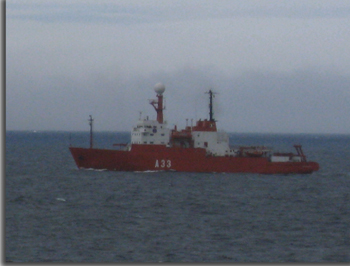
We came across one of the smaller ships that ply these waters. As we suspected, we will not be getting off the ship onto the Antarctic Continent. There is some agreement between nations that the only ships that can offload passengers are those that have 125 passengers or less. Also note that ships now have to use a light marine diesel fuel, which I envision as the same stuff you use in your car. That material will evaporate if spilled, unlike the heavy fuel most often used by marine diesels.
Later. We had dinner with Owen and Annita Evans and had a lovely time in the main dining room. I find it so interesting to meet new people and make new friends. Our paths continue to cross, along with the paths of Rayma Jean/Keith Hawkins and Jeanette/Alex Kajka.
After dinner we attended
the late performance with the magician.
He did some clever things, and was
entertaining.
It was still quite light out at 11 PM,
although the moon was clearly up and shining.
These nights are really short, and at
3 in the morning it is light.
Tuesday, January 22
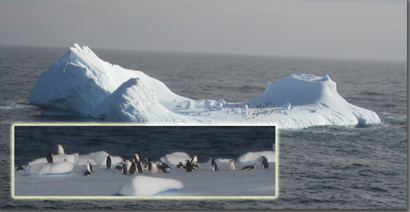 I
must say that one quickly becomes jaded.
The first iceberg and the first whales
were thrilling.
Now, after
the 15th
or so of either, we have all become a bit more blasé’.
I
must say that one quickly becomes jaded.
The first iceberg and the first whales
were thrilling.
Now, after
the 15th
or so of either, we have all become a bit more blasé’.
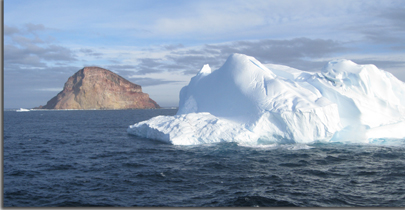
We are below the 63rd
parallel, and heading south.
I think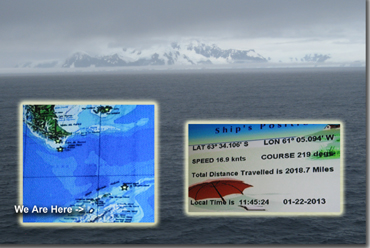 someone said we will go as far as 67, which is pretty far south.
We are inside the Antarctic Sound,
with the continent on one side, and the outer barrier islands on the
other.
There are plenty of icebergs,
dolphins, penguins, and whales.
This is a forbidding place, and even
here in summer it is harsh.
someone said we will go as far as 67, which is pretty far south.
We are inside the Antarctic Sound,
with the continent on one side, and the outer barrier islands on the
other.
There are plenty of icebergs,
dolphins, penguins, and whales.
This is a forbidding place, and even
here in summer it is harsh.
The early explorers really had their work cut out for themselves on their race to the south pole. Our on board speaker related the history of the race in the early 1900’s. Think of it as the Space Race of the time. Amundsen and his Norwegian team were the first ones here, with the British team, led by Scott, coming in second about a month later. The difference between the two expeditions was remarkable.
Amundsen put together a team of five, all with considerable polar experience. Amundsen had honed his polar skills in the Northwest Passage, learning from the Inuit how to survive and thrive in extreme cold. So he had animal skin clothing and other utilitarian items that helped men survive in bitter cold. His team used dogs as their mode of transport assistance, but viewed the animals as sources of protein. He started with 56 sled dogs, and finished with 11. He also viewed the race of the pole as simply that – a race. There was no attempt to seek geological samples, take a lot of photos, or look at any fauna. He planned meticulously for a straight in dash and the return. And he did return, with the expedition actually arriving back a base camp a week early.
Scott on the other hand, was in it for the glory of Britain. His team was not as much a team, as a group of unprepared men. They planned to use untested powered snow machines and ponies for transport. They did not view their dogs as sources of food, although they eventually came to realize the potential in eating them. The ponies were soon sacrificed for dog and human food, and the snow machines froze and were abandoned. As I said, they were unprepared for polar exploration, not even being experienced skiers. Their clothes were cloth, as opposed to animal skins. They rambled and took lots of photos, geological samples, and penguin eggs. Scott’s team arrived at the South Pole roughly a month after Amundsen. Their return was initially marred by the deaths of two team members, one due to suicide. Scott and the remainder of the team did not make it back to base camp, freezing to death only 11 miles from a supply cache and around 110 miles from base.
One of the great polar
expeditions is that of Shackleton.
He got to within 112 miles of the
pole, but was forced to return to his ship.
He later told his wife, “Yes, I failed
to reach the pole, but would you rather have a dead lion or a live
donkey?”
Shackleton’s ship and its crew of 29
men got trapped in the ice.
Seeking rescue, Shackleton took six of
his crew. Leaving the other 22 on the continent, and set off in an
open topped boat to seek rescue.
They sailed some 800 miles in icy
waters and storms to reach New Georgia Island.
Their voyage stands as a remarkable
open boat voyage.
Once at the island, they landed on the
uninhabited side, and so they had to cross.
They left three men behind, and four
of them hauled their boat to civilization.
They had to cross ice crevasses and
snow fields, and even today, it is an arduous trek.
In one instance, they we stymied by an
ice wall and had to slide down 1500 meters on their butts.
Shackleton kept them going, knowing
that to stop meant freezing to death.
Eventually they got to the whaling
station and immediately went to get the other 3 on the other side of the
island and then back to Elephant Island.
All 29 men survived.
It is a remarkable story of survival.
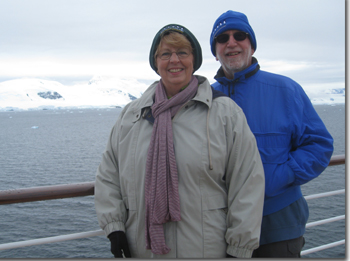 We
were there! Ice and snow and the Antarctic continent in the
background. What an experience. Those past readers will note
that I am wearing Old Blue. That coat has been around!
We
were there! Ice and snow and the Antarctic continent in the
background. What an experience. Those past readers will note
that I am wearing Old Blue. That coat has been around!
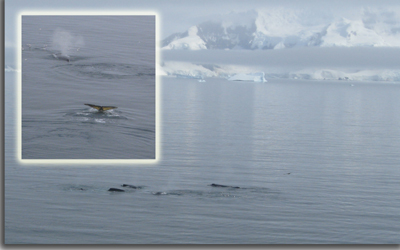 We
are seeing lots of whales – fin, orca, blue and humpback.
Plus the penguins, so there must be a
good food supply of krill in the area.
An interesting technique the whales
use for gathering krill is called bubble netting.
A pod will make a circular “net” of
exhaled air.
The krill are then trapped in the
circle, and the whales take turns coming up in the center of the ring to
feed.
One of the passengers got a really
great shot using a UV filter.
Alas, I was not so fortunate.
We
are seeing lots of whales – fin, orca, blue and humpback.
Plus the penguins, so there must be a
good food supply of krill in the area.
An interesting technique the whales
use for gathering krill is called bubble netting.
A pod will make a circular “net” of
exhaled air.
The krill are then trapped in the
circle, and the whales take turns coming up in the center of the ring to
feed.
One of the passengers got a really
great shot using a UV filter.
Alas, I was not so fortunate.
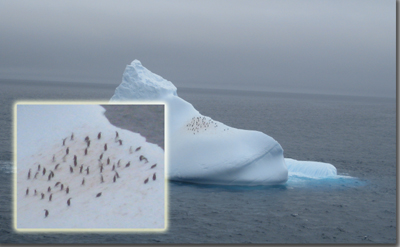 As
the afternoon wore on, we were greeted with even more icebergs.
So how do icebergs make it out into
the South Atlantic and Pacific?
There is a circum-antarctic current
that produces a vortex.
The bergs just circle around the
continent and then get spun out into the southern oceans.
As
the afternoon wore on, we were greeted with even more icebergs.
So how do icebergs make it out into
the South Atlantic and Pacific?
There is a circum-antarctic current
that produces a vortex.
The bergs just circle around the
continent and then get spun out into the southern oceans.
One of our new friends, Keith Hawkins, was extremely lucky, and happened to catch the breakup of a passing iceberg. You can see his video here. (TRT 3:23)
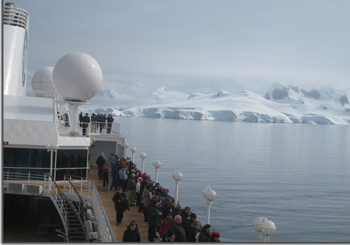
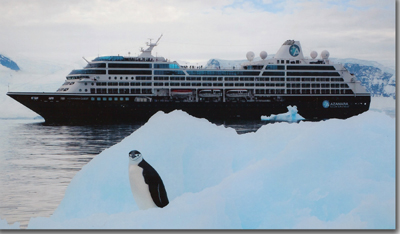
As the seas were so calm, and the skies so blue, the ship put out a zodiac so that the ship photographer could get some promo shots of the ship in the ice floes.
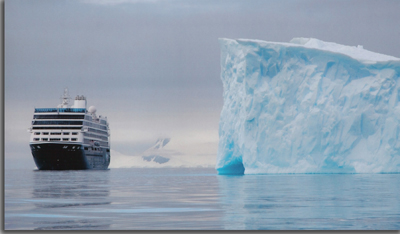 This
should offer a better perspective on the size of these icebergs.
And perhaps why the Titanic ended up the way it did.
This
should offer a better perspective on the size of these icebergs.
And perhaps why the Titanic ended up the way it did.
The late evening program was a 60’s and 70’s music revival, which was perfect for this audience.
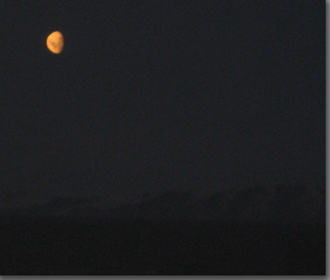
The moon is almost full this evening. We headed up to the Looking Glass lounge for an ABBA retrospective presentation.
The ship is pretty much
stopped, as night running in close quarters with all this ice around is
not safe, even with the modern navigational aids.
Wednesday, January 23
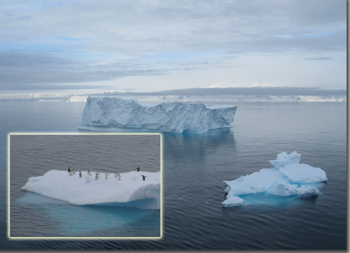 This
morning we were as far south as we are going to go, and were once again
treated to penguins swiming and jumping onto the icebergs, many more whales
and birds.
And we had lots and lots of icebergs
around us.
It's a spectacular site of white ice against a bright blue sky and dark
blue ocean. The ocean area around the iceberg is a beautiful aqua blue.
So the contrasts are beautiful!! Some
of the icebergs were quite large, I dare say as large as the ship.
They were not something that I would
want to bump into in the middle of the night – much less the day.
More of Antarctica and whales can be seen
here.
This
morning we were as far south as we are going to go, and were once again
treated to penguins swiming and jumping onto the icebergs, many more whales
and birds.
And we had lots and lots of icebergs
around us.
It's a spectacular site of white ice against a bright blue sky and dark
blue ocean. The ocean area around the iceberg is a beautiful aqua blue.
So the contrasts are beautiful!! Some
of the icebergs were quite large, I dare say as large as the ship.
They were not something that I would
want to bump into in the middle of the night – much less the day.
More of Antarctica and whales can be seen
here.
We poked around a bit
near a former Argentine research station that had burned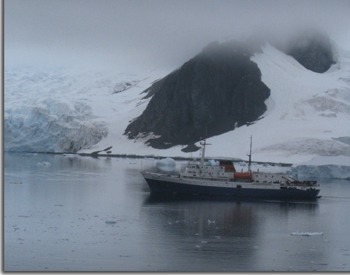 back the early 1980’s and saw a small cruise ship ferrying passengers in
to set foot on the Antarctic continent.
I’m a little sorry that we did not get
to do this, but I’m calling our proximity of a half mile as close enough
to count.
Would I like to see the active volcano
at Mt. Erebus?
Well maybe.
But it is not a loss if I miss it.
Besides, it is hundreds of miles away.
back the early 1980’s and saw a small cruise ship ferrying passengers in
to set foot on the Antarctic continent.
I’m a little sorry that we did not get
to do this, but I’m calling our proximity of a half mile as close enough
to count.
Would I like to see the active volcano
at Mt. Erebus?
Well maybe.
But it is not a loss if I miss it.
Besides, it is hundreds of miles away.
Our morning lecture was on continental drift, and explained why the temperature here was initially at an average of 50 degrees. Fossils and rock strata have confirmed the continental drift theory as posited by Ben Franklin and a German, Wegner?.
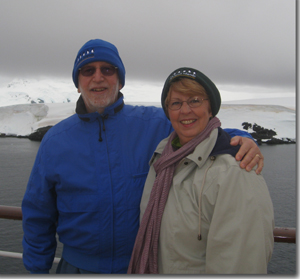 We
turned North out into the open sea, and are running almost due North.
We are trying to get ahead of a
weather front that would make Drake Passage rather unpleasant.
We are still seeing large icebergs,
whales and penguins.
People have reported seal sightings,
but I have not seen one.
The weather alternates between fog,
low hanging clouds, thin overcast and bright sun.
People are going to think that all my
photos are in black and white, but there is an absence of color.
Everything is black and white, other
than the deep blue of the compressed ice.
We
turned North out into the open sea, and are running almost due North.
We are trying to get ahead of a
weather front that would make Drake Passage rather unpleasant.
We are still seeing large icebergs,
whales and penguins.
People have reported seal sightings,
but I have not seen one.
The weather alternates between fog,
low hanging clouds, thin overcast and bright sun.
People are going to think that all my
photos are in black and white, but there is an absence of color.
Everything is black and white, other
than the deep blue of the compressed ice.
Thursday, January 24
We are running between 18.5-19 knots today which is top speed. We are trying to stay ahead of the storm which is about 2 hours behind us. Even so, the swells will rise to around 4 meters later in the day.
Our enrichment lecture this morning was about Ushuaia. It was not a particularly positive history, as the initial major player, was a Romanian named Julius Popper. He found gold in southern Tierra del Fuego, set himself up as a despot, even going so far as to print currency, issue stamps, and set laws. Because the native peoples, primarily the Ona, were killing sheep and cattle, he put a bounty on them, and basically had the entire population killed. Eventually he was ousted, with Argentina making this one of their largest provinces. Tierra del Fuego, by the way does not refer to volcanic activity as I originally thought. There is hardly any of that here. Instead it refers to the hillside bonfires that the indigenous peoples built. The people were interesting physiologically in that they were quite tall, and had adapted very well to the lower temperatures.
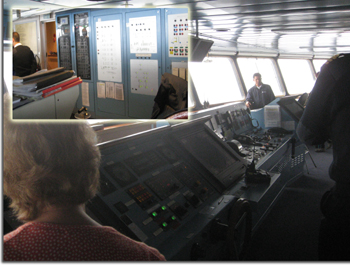 Anglican
missionary Thomas Bridges set up the first house here, and tried to
protect the natives.
He failed.
The Argentinians and the Chileans have
not gotten along in the past.
The Beagle Channel is the separation
point between the two countries.
One reason for the city was as a
penitentiary.
They even built a narrow gauge
railroad to haul firewood out of the forest.
See the Tracks Ahead
segment on the "Tren del fin del Mundo."
It rains a great deal in Ushuaia, with
a climate much like Seattle – lots of drizzle.
So there isn’t much actual rainfall.
Anglican
missionary Thomas Bridges set up the first house here, and tried to
protect the natives.
He failed.
The Argentinians and the Chileans have
not gotten along in the past.
The Beagle Channel is the separation
point between the two countries.
One reason for the city was as a
penitentiary.
They even built a narrow gauge
railroad to haul firewood out of the forest.
See the Tracks Ahead
segment on the "Tren del fin del Mundo."
It rains a great deal in Ushuaia, with
a climate much like Seattle – lots of drizzle.
So there isn’t much actual rainfall.
After the talk we headed off for a bridge tour. I’ve done these before, but they are always interesting. GPS plays such a major role in navigation these days, although the crew still can rely on dead reckoning and paper and pencil.
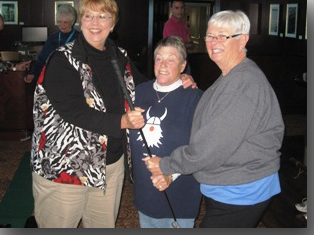 Barb,
Naomi and Anne teamed up for a putting event on board. It wasn't
SCG Lady Putters, but was fun. I wonder if they will get
"birds" for their holes in one!
Barb,
Naomi and Anne teamed up for a putting event on board. It wasn't
SCG Lady Putters, but was fun. I wonder if they will get
"birds" for their holes in one!
Photo by Chuck
Noon found us at trivia, followed by choir practice.
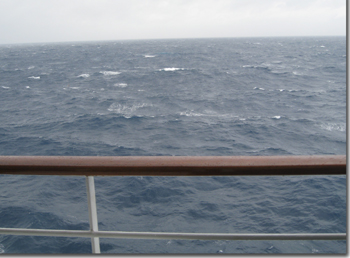 Paul
and I met Keith and chatted for a couple of hours.
He was an air force pilot and after he exited the military, flew for
UPS, primarily on a Louisville to China run. It was great to hear
some of his stories, and swap tales of our various lives.
Paul
and I met Keith and chatted for a couple of hours.
He was an air force pilot and after he exited the military, flew for
UPS, primarily on a Louisville to China run. It was great to hear
some of his stories, and swap tales of our various lives.
We are
experiencing very rough seas as we
close in on Cape Horn.
Things are really rocking and rolling.
Most people are in their cabins,
buttoned up for the evening.
We spent at least the
first half of last night rolling around in our cabin.
The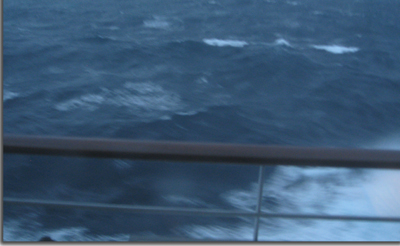 swells were up to 8 meters (30 feet) and the winds were sustained at 50+
mph with gusts to 100.
That qualifies as hurricane force.
Attempting to open the balcony door
was a major chore, and one of our party actually had the door come off
the sliding track.
Their cabin was like a wind tunnel!
swells were up to 8 meters (30 feet) and the winds were sustained at 50+
mph with gusts to 100.
That qualifies as hurricane force.
Attempting to open the balcony door
was a major chore, and one of our party actually had the door come off
the sliding track.
Their cabin was like a wind tunnel!
I awakened around 1 AM to the sound of a sliding bottle and safely retrieved our liquor bottles and flower vase before they hit the floor. Like I said, it was a dark and stormy night.
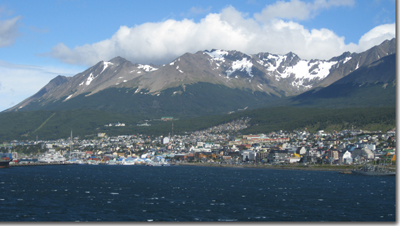 But
this morning found is in the Beagle Channel with sunny, blue skies but
still with a great deal of wind.
The wind was at such a force that we
had to anchor out away from the pier, as the port was closed.
So we spent the day 1800 yards from
Ushuaia, gazing at the whitecaps and the sun lighted city on the shore.
Obviously our shore excursions were
cancelled, and it appears that as we will have to overnight here.
Our short sail around Cape Horn has been cancelled as well, as the
weather is just to poor to go down there.
But
this morning found is in the Beagle Channel with sunny, blue skies but
still with a great deal of wind.
The wind was at such a force that we
had to anchor out away from the pier, as the port was closed.
So we spent the day 1800 yards from
Ushuaia, gazing at the whitecaps and the sun lighted city on the shore.
Obviously our shore excursions were
cancelled, and it appears that as we will have to overnight here.
Our short sail around Cape Horn has been cancelled as well, as the
weather is just to poor to go down there.
Worse, the ship was
supposed to put on fuel and additional provisions. All were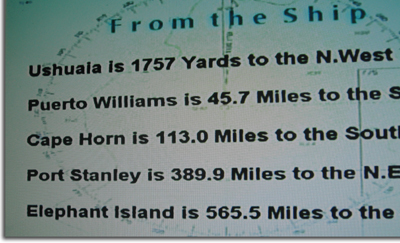 prepaid, and just sitting at the dock, 1800 yards away.
Heaven forbid that we should run shore
of food and have to miss a
meal!
prepaid, and just sitting at the dock, 1800 yards away.
Heaven forbid that we should run shore
of food and have to miss a
meal!
Later.
The winds did not abate, as while the
crew made an effort to get into the pier around 2 AM, they were
unsuccessful.
So we turned around and made way for
our next port of call.
Saturday, January 26
Today is an “at sea” day. We are working our way up the east coast of South America on our way to Puerto Madryn.
While the weather for the last several days has dictated coats and hats, the coming days see us back into the tropics, with shorts and sun screen. This was a tough trip in deciding what to pack. We have gone from high summer, to winter, to summer again.
Today is Australian Day, so there is some celebrating by the 70+ Aussies on board. Plus we are all treated to Australian favorites in food and song.
Otherwise, this was a
slow day.
The weather has cleared and the sun is
out under blue skies.
Sunday, January 27
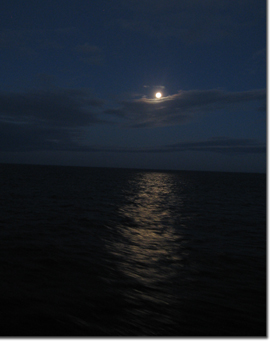 Another
day at sea.
Again, the weather is getting warmer,
and frankly, I think everyone would like to get off this ship for just a
bit.
How did the old sailors spend three
years, or even more at sea?
Again, they were a hardier lot than
all of us.
Another
day at sea.
Again, the weather is getting warmer,
and frankly, I think everyone would like to get off this ship for just a
bit.
How did the old sailors spend three
years, or even more at sea?
Again, they were a hardier lot than
all of us.
We had choir practice for the big show tomorrow, and otherwise, just spent the day relaxing around the ship.
The moon is full, and
casts a gorgeous path along the water.
The days are growing shorter to the
extent that it really is dark by 11 PM or so.
The show tonight was a tribute to
Frank Sinatra via Michael Buble’.
It was a great deal of fun.
Monday, January 28
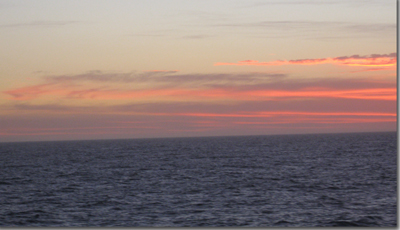 The
days once again start early, although dawn comes later than several days
ago when we were several hundred miles south. It looks like it
will be a gorgeous day.
The
days once again start early, although dawn comes later than several days
ago when we were several hundred miles south. It looks like it
will be a gorgeous day.
Finally we have arrived
at Puerto Madryn.
The town is located on the shores of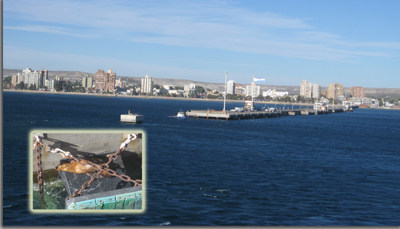 Golfo Nuevo and and is the largest fishing port in Argentina. The
Spanish arrived here in the 17th century, and tried to unsuccessfully
convert the local tribes to Catholicism. In 1865 about 150 Welsh immigrants
arrived, hoping to preserve the Catholic culture.
Their influence can still be seen in
the street names and in some of the language.
Golfo Nuevo and and is the largest fishing port in Argentina. The
Spanish arrived here in the 17th century, and tried to unsuccessfully
convert the local tribes to Catholicism. In 1865 about 150 Welsh immigrants
arrived, hoping to preserve the Catholic culture.
Their influence can still be seen in
the street names and in some of the language.
So we could get off the ship. Ah, not so fast. Once again, high winds were an issue. We were supposed to dock around 8:30 am. But it took the captain until 11 am to ease the ship alongside the pier. And these lazy sea lions never moved an inch. It looked rather relaxing, just languishing in the sun.
As we waited to get off the ship, we listened to the tour people tell stories on one another until our ride to the penguins could commence. We had originally cancelled this tour, but reconsidered after the failure to launch in Ushuaia.
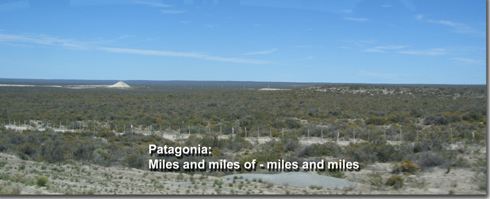 So off we went to see
Magellenic penguins.
This little guys are about three or
four feet tall, and burrow in the ground to make their nests.
The Patagonian scrub makes for good
cover.
So off we went to see
Magellenic penguins.
This little guys are about three or
four feet tall, and burrow in the ground to make their nests.
The Patagonian scrub makes for good
cover.
The ride to Punto Tombo
Nature Preserve took about two and a half hours of driving through the
high steppe of Patagonia.
The terrain looks a little like the
road across Arizona or New Mexico, with low scrub and endless vistas of
– endless vistas.
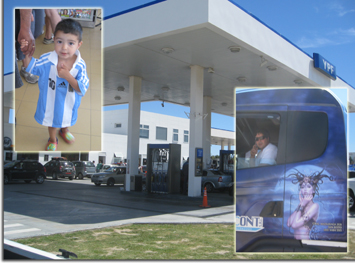
Our first stop was an Argentine truck stop for a bathroom break. All the sights are not necessarily found in nature, as proven by this little boy and the truck driver’s decorations.
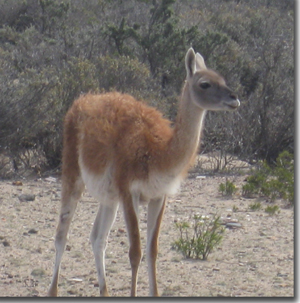 Eventually we arrived at
the preserve, and were initially greeted by a guanaco, which looks a bit
like a llama.
Eventually we arrived at
the preserve, and were initially greeted by a guanaco, which looks a bit
like a llama.
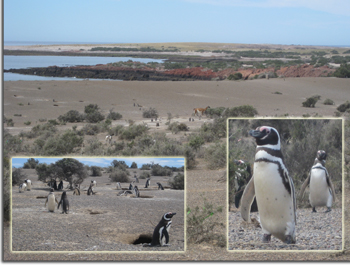
The big attraction was the penguins, and we were greeted by around a million of them. Actually there are around 175,000 mating pairs here. As previously stated, these little fellows are curious and lay their eggs in burrows dug into the soil, usually under the base of a shrub. There were a lot of penguins. There were wooden walkways built up over the migration paths, and penguins had the right of way on all the trails. We were warned not to walk too fast behind the birds, as they then also go faster and have a tendency to overbalance and fall down.
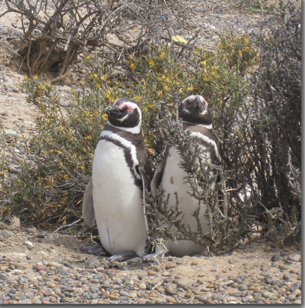 If
the birds weren't preening or getting food, they just sort of stood
around, looking like they hadn't a care in the world.
If
the birds weren't preening or getting food, they just sort of stood
around, looking like they hadn't a care in the world.
I think I may have mentioned that when they preen, they are not only oiling their feathers, but are injecting air under the feathers as well. This trapped air is rather interesting, as if the bird wants to escape from a predator, they can contract their bodies and force the air out, giving them a burst of extra speed under the water.
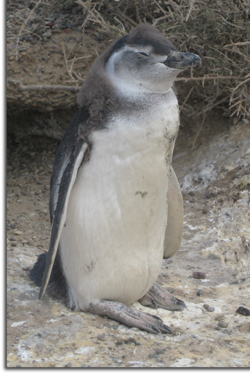
The chicks are just starting to loose their feathers, and mom and dad are still getting groceries out of the ocean, and trekking them back to their offspring. The pairs usually lay two eggs, but generally only the first one survives, as the stronger chick tends to get most of the food. A short penguin sequence is here.
Then back on the bus for a nap as we headed back to the ship.
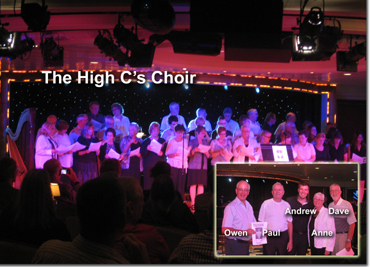 Tonight was the Big
Passenger and Crew Talent Show. Owen, Paul, Anne and I put forth our efforts as a part of the High
C's Choir. There were many amateurs on both the passenger and crew
list before us, although I'd like to think that we were worth the wait.
Andrew, our leader, did a wonderful job of making 40 people from a
number of different countries sound great. We all enjoyed
performing some of Andrew Lloyd Webber's songs. It was a blast, and we sounded awesome!
Tonight was the Big
Passenger and Crew Talent Show. Owen, Paul, Anne and I put forth our efforts as a part of the High
C's Choir. There were many amateurs on both the passenger and crew
list before us, although I'd like to think that we were worth the wait.
Andrew, our leader, did a wonderful job of making 40 people from a
number of different countries sound great. We all enjoyed
performing some of Andrew Lloyd Webber's songs. It was a blast, and we sounded awesome!
The cruise is winding
down, with only two more days at sea.
Tuesday, January 29
A day at sea.
Predicted temperatures of Buenos Aires
is 104.
Yikes.
We did trivia at Noon and other than
that, not too much was accomplished today.
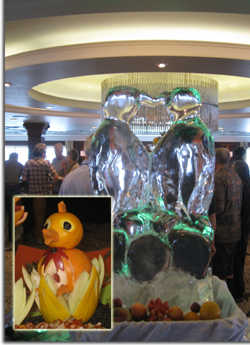
We did attend a lecture on Darwin, which turned out to be a lot more interesting than anticipated. Darwin himself had a difficult time resolving the spiritual side of life with the scientific side, a debate which continues to this day.
Lunch was a brunch, with as usual, waaay too much food. Some of the carvings may be duplicated back at home. Perhaps!
Evening saw us at the seafood restaurant, after drinks in the Looking Glass.
Then the final crew show, where the crew, representing 41 nations, were introduced.
This has been a really nice
experience, and we both think the reason is because There was a good mix of
relaxing days at sea and site seeing.
So it wasn’t the usual go, go, go
scenario.
If you had told me ten years ago that
I would enjoy cruising of this nature, I would have thought you crazy.
Wednesday, January 30
This is our final full day on the ship. So the morning was spent packing. No need to worry about wrinkles now!.
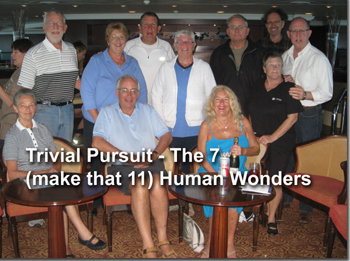 We have
our team trivial
pursuit party at 11, followed by the last trivial pursuit challenge. At
our party we will get to see one of the largest suites on the ship, as
our hosts, a couple from Henderson, NV, have been
on 27 of the Azamara Cruises, many of them back-to-back.
This time they are on the ship until mid-March.
Then I’m sure we will continue
packing,
But for now, our trivial pursuit answers are A) Matt Munroe, B) Samuel
Pepys or C) lawn bowling. Although the answer to "How did Richard
the 2nd die?" is, "He fell off the toilet."
We have
our team trivial
pursuit party at 11, followed by the last trivial pursuit challenge. At
our party we will get to see one of the largest suites on the ship, as
our hosts, a couple from Henderson, NV, have been
on 27 of the Azamara Cruises, many of them back-to-back.
This time they are on the ship until mid-March.
Then I’m sure we will continue
packing,
But for now, our trivial pursuit answers are A) Matt Munroe, B) Samuel
Pepys or C) lawn bowling. Although the answer to "How did Richard
the 2nd die?" is, "He fell off the toilet."
The weather forecast for
Buenos Aires tomorrow is still around 28 degrees.
I think we will stay on the air
conditioned bus all day.
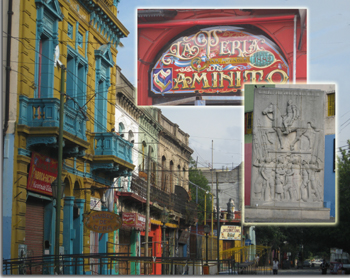 our newly made friends. The tour buses were waiting, and our carry
on luggage was stowed underneath. Our checked bags are supposed to
meet us at the international airport this afternoon. Our flight
does not leave until 10:30 PM, so we have a whole day to kill. As
it turns out, today is an Argentinian holiday, celebrating the
Bicentennial of the Constituent Assembly of 1813. So pretty much
everything was closed.
our newly made friends. The tour buses were waiting, and our carry
on luggage was stowed underneath. Our checked bags are supposed to
meet us at the international airport this afternoon. Our flight
does not leave until 10:30 PM, so we have a whole day to kill. As
it turns out, today is an Argentinian holiday, celebrating the
Bicentennial of the Constituent Assembly of 1813. So pretty much
everything was closed.
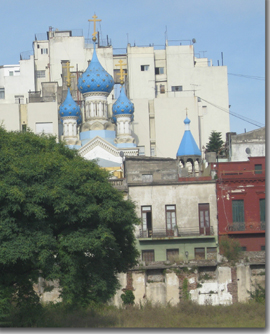
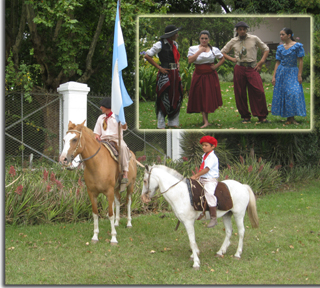
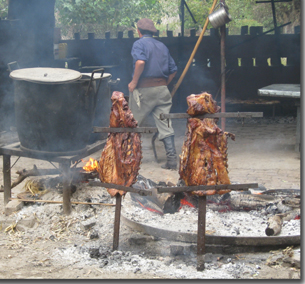
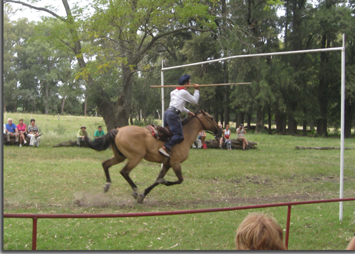
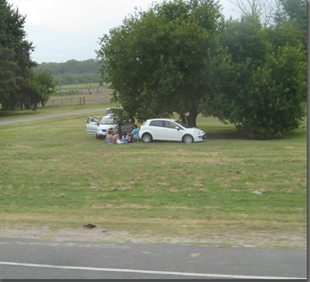
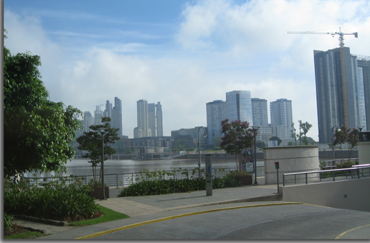
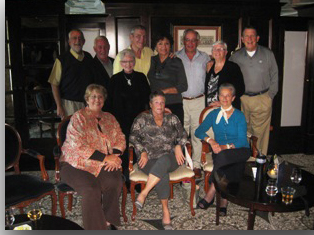 can
be.
can
be.